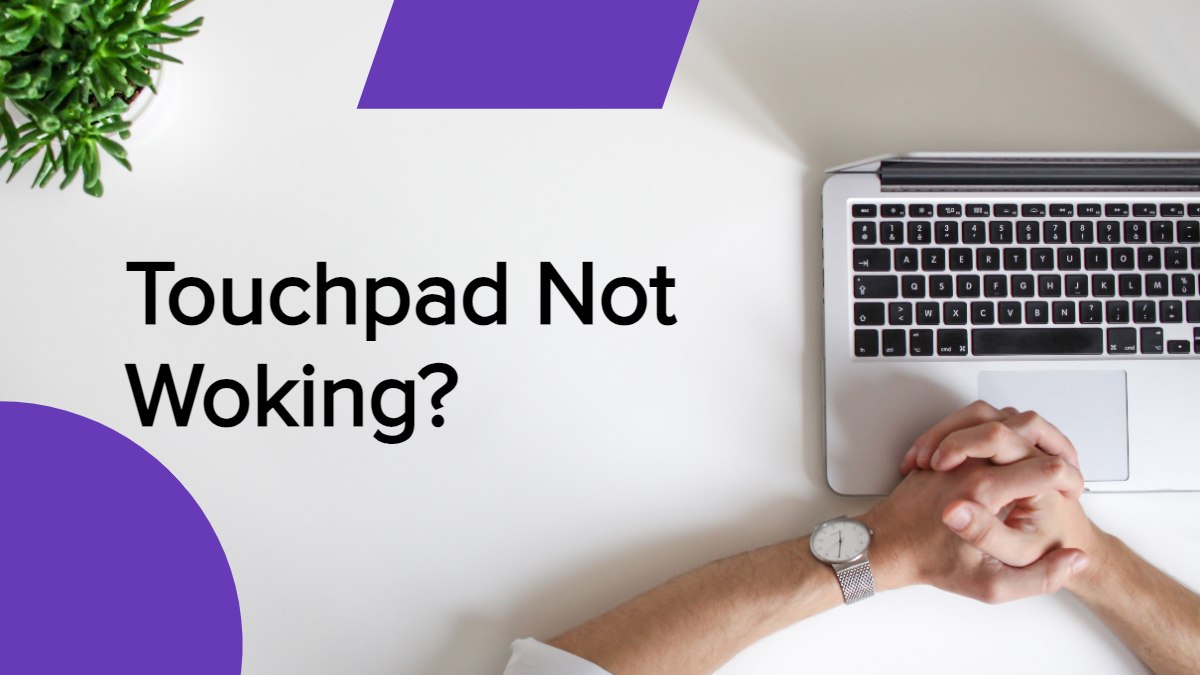It’s easy to get into a little bit of panic when your laptop’s Touchpad is not Working. And without moving the Cursor there is less to do with a laptop or a computer.
It also seems frustrating when we are in an important working situation.
But don’t be too hopeless about it, – there are still some steps you can take to get rid of this problem.
We will show you some simple Troubleshooting steps to fix your Touchpad not Working and get back to working conditions.
In general, the problem occurs due to a Broken Driver, turned off trackpad on Settings, – or a Physical device like a Mouse taking input authority so the trackpad stops working.
In This Article
Check if Your Laptop is Frozen or Crashed
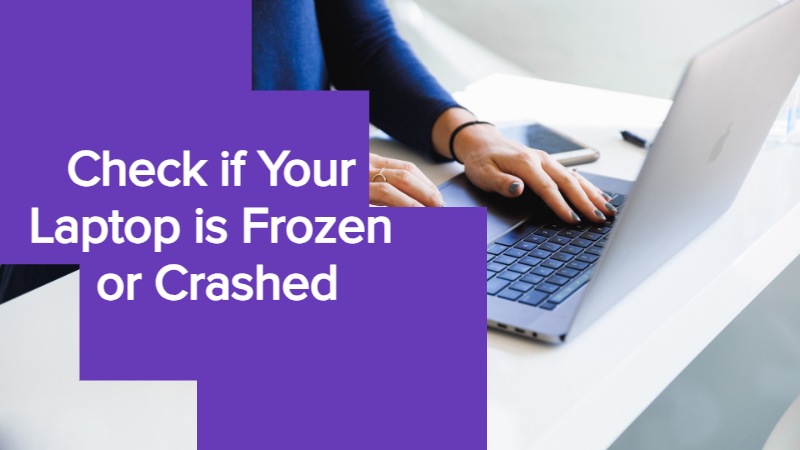
First, check if your Laptop is Frozen or Crashed. This sounds a little bit uncomfortable, – but it’s worth checking it.
Check if the Touchpad or the Whole Laptop is Frozen or Crashed due to overloading.
If so, try turning OFF your Laptop Manually by removing the Battery or Unplugging the Power Cord and turning the Laptop ON again.
On the other hand, if your Laptop is locked up totally, – neither the Touchpad nor the keyboard will work.
To check this on Windows, – press the Windows Key to open the Start menu, – and press the Ctrl+Alt+Delete button at the same time to open the Security screen.
On Mac, – hit Cmd+Space to open Spotlight, – which is the easiest way to check your laptop is working.
Thus you can review the common reasons why your Laptop Touchpad not Working if you want to diagnose the issue or try fixing Windows Lock-up settings.
If this can’t solve the issue, – try our next step.
Make Sure Your Touchpad is ON
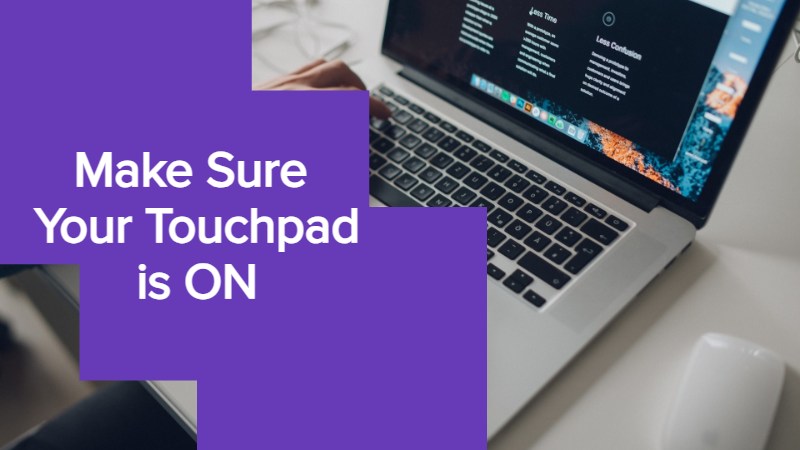
So, make sure your laptop’s Touchpad is ON.
One of the most common problems of the laptop Touchpad not Working is that you accidentally turned it off with a Key combination.
Usually, there is a little LED light near the Touchpad that remains ON if your Touchpad is ON.
Most Laptops have a Fn Key that Combines with – F1, F2, F3, F4, F5, F6…..F12 to perform special operations.
These functions do various tasks like Brightness Control, Turning OFF/ON WiFi, Volume Control, opening new tabs on the Browser, etc.
In some Laptops, a Trackpad can also be Enabled/Disabled with one of these key combinations.
Since it’s easy to turn your Touchpad OFF mistakenly you can also Turn it ON by pressing the same Key Combination.
The exact Key Combination Depends on the Laptop’s Brand.
On HP laptops, – it’s often F6 or F9, – but it can vary.
Press and hold the “Fn” key (usually located near the bottom-left corner of the keyboard).
While holding the “Fn” key, – press the Function Key with the touchpad icon. Do the same things with other brands.
Or open the Windows Settings menu by pressing the Windows Key+I > Select Devices/Bluetooth & devices > Select Touchpad from the right-hand menu > Toggle the Touchpad ON.
Then try your Touchpad to see if it’s solved or not.
You can also lock the Touchpad if you find yourself hitting often by mistake.
Remove Any External Mice to Activate the Touchpad
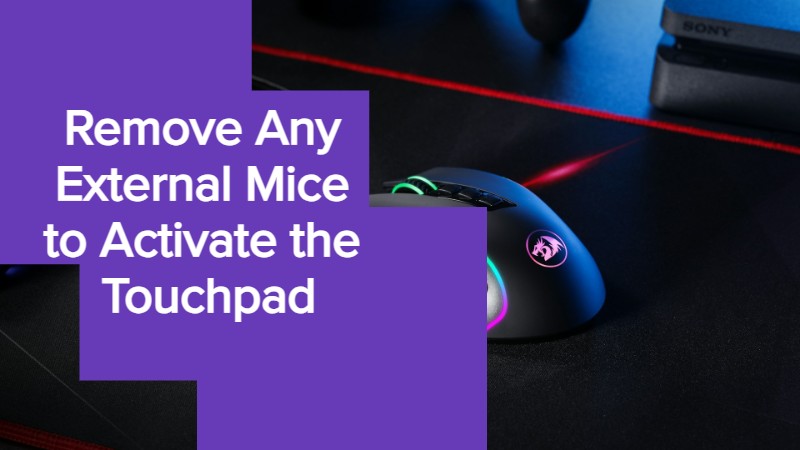
Another Simple but important step to solve the Touchpad not Working issue is to try Unplugging all USB input devices you’ve connected to your laptop.
You need to unplug the Wireless Mice Too.
The reason for this is that some laptops or Windows and MacOS themselves have a common feature that automatically turns off your Touchpad – if an external mouse is connected to the laptop.
This could be the issue of why your Touchpad is not Working.
If still the Touchpad is not functioning properly – try shutting down your system, unplug all connected non-essential devices and accessories, – and then boot your system again.
If rebooting your system solves the problem you’ve found the reason – why Touchpad was unresponsive.
You can also adjust this setting to keep your Touchpad active even with an external mouse plugged in.
Review Touchpad Options in Settings
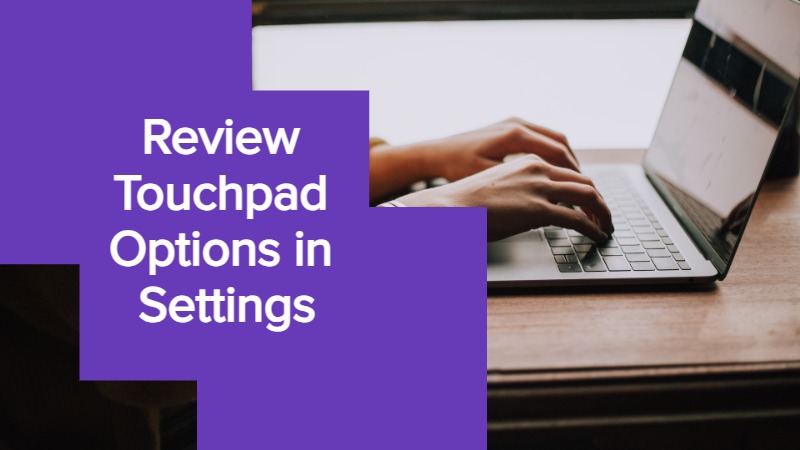
You should also check the Touchpad settings in Windows to see if everything is good there.
As I mentioned before, – Go to Windows settings by pressing Windows Key+I > Bluetooth & devices > Touchpad on Windows 11 & if you’re using Windows 10 then the same pathway will Devices > Touchpad in the Settings menu.
Here firstly make sure your Touchpad is ON and keep ON the option with a checkbox Leave Touchpad ON when a mouse is connected.
This will make sure the Touchpad is active with physical mice at the same time.
Also, you can customize other options related to Touchpad. And if this can’t solve your problem, – you might be able to access more advanced touchpad settings in another location.
Go to Settings > Devices/Bluetooth & devices > Mouse and click Additional mouse settings.
On Windows 10, this appears as a link on the right side. If you don’t see it, – drag the Settings window horizontally until it appears.
On Windows 11, this is an entry at the bottom of the list.
Now you can see a dialog box and you should see a tab on the top right side labeled Device settings, Touchpad/Trackpad, or something similar.
Click on it and check if the device was enabled. If not, – try re-enabling again to see if that gets your Touchpad working again.
Check Device Manager for Any Driver Issue
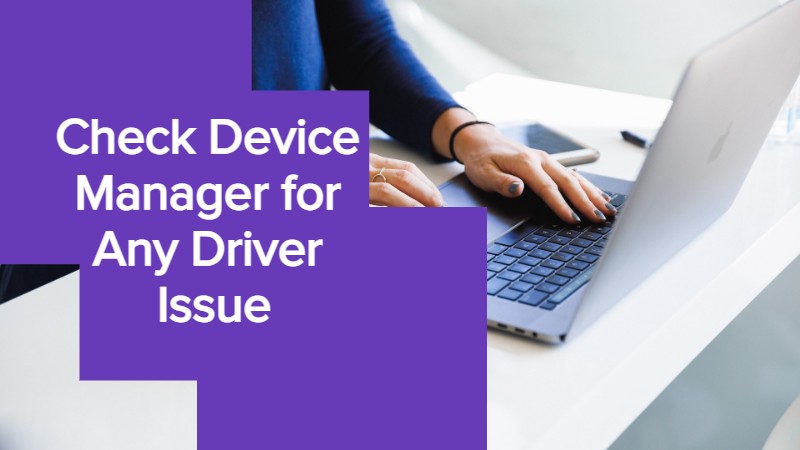
If Your Laptop Touchpad is still not working – it’s likely a driver issue.
So to solve this problem you need to jump into a little deeper troubleshooting method.
Press Win + X or right-click on the Start button to open the Power User menu, – and then open Device Manager.
Here Expand the Mice and other pointing devices category.
You’ll see multiple devices connected to your system. If any of them shows a warning sign ⚠️ that means it has a driver issue.
Double-click on the HID-compliant mouse to see its Location. As you can see, – it says on the USB Input Device.
It means it’s connected through a USB port and it’s not your Touchpad.
Now close this dialog box, – right-click on the HID-compliant mouse & Disable the device and Enable it again.
Next, right-click again and select Update Driver, – then click on Search Automatically for updated driver software.
It will automatically find the latest Driver and install it to your system.
If it says the best Drivers for your device are already installed, – click on search for updated drivers in Windows Update.
This setting will download the latest driver through the Windows Update Channel, – and your issue can be cleared.
If Windows doesn’t do anything then go to your manufacturer’s Utility Software and check for any updates.
Otherwise, run a Google Search with your Laptop model + drivers and look for a Downloads & Updates section on the Manufacturer ⚠️ (don’t use any of the third-party websites to download drivers) website related to your device model.
Download and Install the Latest Driver to see if it fixes your Touchpad Issue.
Review Touchpad Settings in the UEFI/BIOS

Your Laptop’s BIOS or UEFI is the main Administrator of the System. It controls many settings independently and can override Windows Settings.
And it’s possible that your Touchpad is Disabled in BIOS, – so Windows can’t access it.
You’ll need to enter the BIOS by pressing F2, Delete, – or other BIOS Keys continuously as you turn it on.
Another way to access the BIOS is to restart the system and continuously tap the Delete or F2 key until you successfully enter the BIOS.
Now look for any options called Touchpad, Trackpad, or similar options. These options can be in the Advanced Settings tab.
Once you’ve found it, – try Enabling and Disabling it so that Windows can recognize it.
That could solve your problem or you might need to do some extra steps to complete the process after Enabling the Touchpad In BIOS.
Disable Tablet PC Services if You’re Using Multi-Purpose Laptop
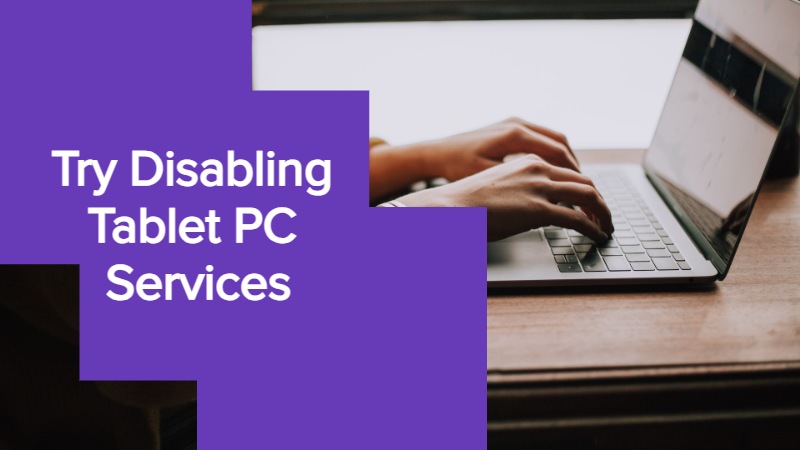
Windows Laptops that have a Touchscreen, – such as Multi-purpose Laptops, – have a special feature called Tablet PC Input Service.
That controls whether it’s the Touch Screen or the Trackpad or both can input at the same time.
Like it Disables the Trackpad when you’re in Tablet mode.
There is a slight possibility that this service may interfere with the touchpad, – causing it to become disabled.
It’s worth looking as if nothing else has helped to this point.
To verify this, – type “services” into the search box on your Start Menu and Launch the Services Utility option.
Here, scroll to Tablet PC Input Service, – right-click on it, and choose Stop.
If the Touchpad Starts working after doing this you’ve found the issue, – that prevented the Touchpad Functioning.
NOTE: You may need to restart your laptop after Disabling or changing any Settings.
To keep this service from loading every time you boot up, – double-click it and set the Startup type to Manual.
⚠️ Disabling this service may cause Dysfunctional behaviors when in Tablet mode.
Touchpad Still Not Working? – You May Have a Hardware Issue
The above steps should fix the majority of the problem that causes the Touchpad to be Unresponsive.
If still, you can’t do anything with your Laptop’s Touchpad there may be a Hardware Issue. Perhaps the connector cable is broken or loosened or the Touchpad has worn out if it’s too old.
In this case, you need to take your computer to a repair shop and get a Professional opinion, – or just start using an external mouse.
Frequently Asked Questions (FAQs)
Q1. How do I Fix my Unresponsive Touchpad on my Laptop?
A: Check if the Dirt or Oil is stuck on the Touchpad, Restart your Computer. Update the driver in Device Manager, and try disabling external accessories like the Mouse and Keyboard.
Also, enable the Touchpad in BIOS settings & Windows settings, and try Resetting Tablet PC services if you’re using a multi-purpose laptop.
Q2. How do I turn my Touchpad back on?
A: Use a Key combination on your laptop like FN + F5, F6, or F8 depending on the Laptop model, – or turn it on from BIOS settings. Usually, the Touchpad Automatically turns“ON ” after you restart your Laptop.
Q3. How can I Reset my Touchpad?
A: Go to Windows settings select Devices/Bluetooth & devices > Touchpad, – and scroll down until you see Reset your Touchpad. Then click on the “Reset” button and this will get you back to the default settings.
Q4. Can a Laptop Touchpad be Disabled?
A: Yes, a Laptop touchpad can be Disabled in Windows Settings or in BIOS settings or using a Key combination.
Q5. Why is my HP Touchpad Not Working?
A: It’s most likely that the touchpad is turned OFF. Enable HP touchpad in the Windows Settings or using a key combination like – Fn+F5, Fn+F6, or Fn+F8.
Additionally, check your BIOS settings to ensure that the touchpad is not disabled there.
Q6. How do I Unfreeze my Touchpad Mouse?
A: Clean the surface of the touchpad, update the driver to the latest version, – remove any external devices, – and disable Tablet PC services if you’re using a multi-purpose laptop.
Also, restart your laptop after making any changes in settings.
Q7. What Function Key Disables the Touchpad?
A: It depends on the laptop manufacturer and model. However, most laptops use the FN key in combination with function keys such as – F5, F6, and F8.
You can see a touchpad icon on the function key that disables the touchpad. In some laptops, – there is also a little LED that turns ON when your Touchpad is ON.
Q8. Why is my Cursor Frozen on my Laptop?
A: It’s most likely partial computer crashes, a single application consuming CPU resources, a mouse driver crash, – or the application you’re using freezing.
In the other factor, – it could be that you accidentally press the function keys that disable the touchpad or the touchpad is turned off in the settings.
Q9. Why is my Cursor not Moving?
A: The cursor may stop moving if the application crashes, the operating system fails to execute a large number of data requests simultaneously, – or the mouse driver fails to execute the operation.
Q10. How do I Make my Cursor Appear?
A: Reconnect your mouse to the computer, – update the driver in Device Manager, – check if the mouse is blocked by any applications, review mouse options in the settings, – and also try connecting to other mice.
Q11. How do you Click Without a Touchpad?
A: If you’re using a laptop, – you can click using the physical buttons located in the upper and lower portions of your touchpad. Alternatively, you can use an external mouse to click.
Q12. How do I Manually Turn ON my Touchpad?
A: Use the FN key in combination with function keys such as F5, F6, and F8. Look for a Touchpad icon on one of the function keys and press that button along with the FN keys at the same time.
Also, you can turn it ON from settings in Windows and BIOS.
Q13. How do I Enable my Mouse on my Laptop?
A: Usually, the mouse connects automatically when you plug it in. However, – if your mouse was previously disabled in settings for any reason you can now enable it in settings.
Just go to settings > Devices/Bluetooth and devices > Mouse and enable mouse there.
Q14. How do I Make my Touchpad Auto-Click?
A: In the Accessibility settings, – find the Mouse and Touchpad section. Turn on the switch that says “Automatically click when the mouse stops.”
After doing this, when your cursor stops moving, – a circle will appear around it. If the cursor stays still for a bit, – it will automatically click.

